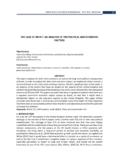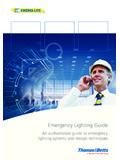Transcription of SMART CITY SERVICES DRIVEN BY IOT: A …
1 40 SMART city SERVICES DRIVEN BY IOT: A SYSTEMATIC REVIEW SMART city SERVICES DRIVEN BY IOT: A SYSTEMATIC REVIEW Marko Mijac Faculty of Organization and Informatics, University of Zagreb Pavlinska 2, 42000 Vara din, Croatia Darko Androcec Faculty of Organization and Informatics, University of Zagreb Pavlinska 2, 42000 Vara din, Croatia Ruben Picek Faculty of Organization and Informatics University of Zagreb Pavlinska 2, 42000 Vara din, Croatia ABSTRACT The central role in development of information society is taken by SMART cities and their novel SERVICES through the use of modern technology and SMART solutions. The key enabler and driver of SMART cities is Internet of Things (IoT). In this paper, we have conducted a systematic literature review in order to investigate proposed SMART city SERVICES DRIVEN by IoT. We have formulated the review protocol to define the research question/s, search strategy, selection criteria, study quality assessment, and data extraction strategy.
2 We have defined the following main research question: What are the reported applications of Internet of Things in the development of SMART city SERVICES ? The papers were categorized by the SMART city SERVICES they proposed or described. We have recognized the following categories: traffic and transport; environment monitoring; accessibility & healthcare; waste management; public lighting; energy management; city infrastructure; and other. Keywords:Digital transformation; Information society; Internet of Things; SMART cities 41 Journal of Economic and Social Development Vol 4. No 2., September 2017 1. INTRODUCTION Since its very beginnings, information and communication technology has been reshaping our society. It introduced the changes in our private lives: how we interact with people and environment. Equally it impacted the way we are doing business and how our governments and public administrations interact with us.
3 These effects have been so immense, that it is hard to believe that the advent of personal computers, World Wide Web, smartphones and other enabling technologies has happened in just a few decades. More than ever, we deserve to call ourselves information society. The central role in development of information society belongs to SMART cities. Although the formal definition of SMART city is not yet widely adopted, according to Zanella et al. [1], the final aim of SMART city is to make better use of public resources, by increasing the quality of SERVICES offered to citizens, and at the same time reducing operational costs of the public administration. Delivery of SMART SERVICES in cities requires the ability to sense the city and gather data about its environment, infrastructure, events, and inhabitants. Therefore, it does not come as a surprise that the key enabler and driver of SMART cities is Internet of Things (IoT).
4 Origins of the term Internet of Things date back in 1999 when Kevin Ashton proposed it as uniquely identifiable interoperable connected objects with radio-frequency identification (RFID) technology [2]. Since then, the concept became broader and encompassed more of the evolving technologies. While no single definition has been accepted, the core concept of IoT assumes billions of everyday things being embedded with microprocessors, software, sensors and connected to Internet, thus participating in this vast network by sensing their environment, generating, collecting, and exchanging information. The notion of thing is quite flexible and encompasses a wide range of different SMART and autonomous devices, as well as very simple the help of IoT, SMART cities can reshape existing traditional city SERVICES into SMART SERVICES , as well as offer novel SERVICES .
5 Such may include environmental monitoring, traffic SERVICES , monitoring and optimizing energy consumption, security, healthcare and other SERVICES . Therefore, the goal of this paper is to investigate how SMART city SERVICES are DRIVEN by IoT. The literature review will be conducted in order to obtain proposed IoT enabled solutions for SMART city SERVICES . The paper is organized as follows. The second section provides a description of research method used to review papers on IoT and SMART cities. The third section contain an overview and a meta-analysis of relevant papers. The results of the review and discussion are presented in section four. Finally, the last section concludes the topic. 2. RESEARCH METHOD To examine IoT-enabled SMART city SERVICES , we have conducted a systematic literature review following steps listed in Kitchenham s[3] work.
6 We have formulated the review protocol with aim to define the research question/s, search strategy, selection criteria, study quality assessment, and data extraction strategy. Defined research question For purpose of this research, we have defined the following main research question: What are the reported applications of Internet of Things in the development of SMART city SERVICES ? 42 SMART city SERVICES DRIVEN BY IOT: A SYSTEMATIC REVIEW Search strategy We have used two keywords (Internet of things and SMART city ) to construct search query: SMART city AND Internet of Things . Next, we have chosen the following scientific databases as relevant for our topic: SCOPUS, IEEE Xplore, ACM Digital Library, Google Scholar. We have executed the search query on paper titles and abstracts on the before mentioned sources to get the initial pool of relevant articles. Selection criteria Inclusion and exclusion criteria are listed in the Table 1 bellow.
7 First, we have excluded all duplicate papers (first iteration on Figure 1). Next, we evaluated all remaining papers by their titles and abstracts, and removed the works not related to SMART city SERVICES (second iteration). On the end, we have read the full-text of the remaining papers and exclude low-quality papers and works not focusing on IoT-based SMART city SERVICES (third iteration). INCLUSION AND EXCLUSION CRITERIA Inclusion criteria Exclusion criteria Papers written in English Non-English written papers Publications in scientific conferences or scientific journals Non-reviewed papers, editorials, presentations Works focused on SMART city SERVICES enabled by IoT Papers not related to SMART city SERVICES enabled by IoT Papers that propose IoT-based solution(s) for SMART city service(s) Papers with no concrete solution/s Duplicated studies 3. OVERVIEW OF THE INCLUDED PAPERS Included papers Executing specified search query on selected scientific databases resulted in total of 729 papers.
8 After the inclusion and exclusion criteria mentioned in the previous section of this work were applied, a final number of 96 relevant papers were obtained proposing IoT-based solutions for SMART cities. Number of papers per iteration 43 Journal of Economic and Social Development Vol 4. No 2., September 2017 Publications per years Just a glance at the Figure 2 is enough to spot the trend in publishing papers on SMART city SERVICES enabled by IoT. Prior to 2012 research on this topic has been scarce, but starting from 2013 the number of papers is rapidly increasing. More than 70% of papers were published in 2015 and 2016. The reason for decline in 2017 is the fact that the review was conducted in January 2017. What these data show is that this is relatively new field of research, however, both SMART city and IoT are recent buzzwords, and evidently they are increasingly gaining interest among academic community.
9 Number of papers published per year Types of publications Most of the relevant papers were presented at scientific conferences (58 papers). Other 14 papers were published as journal articles, and two papers are book sections. While conference papers dominate in IEEE and ACM databases, SCOPUS and Google Scholar sources include more journal papers related to a topic of our research. Number of papers per type Citation Analysis Google Scholar s citation report (see Table 2 and Table 3) shows that most of the cited papers have low number of citations, which can be partially attributed to most papers being recently published. 44 SMART city SERVICES DRIVEN BY IOT: A SYSTEMATIC REVIEW PAPER CITATION CATEGORIES Cited by 0 1-9 10-19 20 No. of papers 38 24 9 3 TOP 10 MOST CITED PAPERS Rank Citations Paper 1 40 Sanchez et al. [4] 2 24 Kyriazis et al. [5] 3 20 Ji et al.
10 [6] 4 17 Somov et al. [7] 5 16 Rico et al. [8] 6 15 Cenedese et al. [9] 7 15 Attwood et al. [10] 8 14 Qi et al. [11] 9 12 Zheng et al. [12] 10 12 Abari et al. [13] 4. RESULTS AND DISCUSSION After obtaining the list of relevant papers, the papers were categorized by the SMART city SERVICES they proposed or described. The papers were not restricted to only one SMART city service, therefore, some papers do appear in several categories. Also, the boundaries between each category were not strict, because one particular SMART city service may span over more than one category. In such cases we considered the intention of authors, and placed the service into category which we recognized as dominant. We have recognized the following categories: (1) traffic and transport, (2) environment monitoring, (3) accessibility & healthcare, (4) waste management, (5) public lighting, (6) energy management, (7) city infrastructure, and (8) other.





